
New Evidence Breaks Myths: Giant Sloths and Mastodons Lived Alongside Early Humans for Thousands of Years!
2024-12-20
Author: William
Introduction
SAO PAULO, Brazil - Contrary to popular belief, sloths were not always the slow-moving creatures we see today. Their ancient ancestors were colossal and imposing, weighing as much as four tons (3.6 metric tons) and armed with fearsome claws. For years, it was widely thought that the first humans to reach the Americas hunted these giant ground sloths into extinction, alongside other megafauna such as mastodons, saber-toothed cats, and dire wolves.
Groundbreaking Research
However, groundbreaking research from various archaeological sites is upending this narrative. New evidence suggests that humans arrived in the Americas significantly earlier than previously thought—possibly spending thousands of years living alongside these magnificent creatures rather than hastening their demise.
The Coexistence Hypothesis
Daniel Odess, an archaeologist at White Sands National Park in New Mexico, stated, “The long-held assumption of ‘Pleistocene overkill’—the idea that humans quickly eliminated everything—may not hold up. Instead, it appears that early humans coexisted with these animals for at least 10,000 years without driving them to extinction.”
Archaeological Findings
One of the most compelling findings comes from the Santa Elina archaeological site in central Brazil, where ancient bones of giant ground sloths exhibit signs of human manipulation. These sloths, which once roamed the expanse from Alaska to Argentina, featured bony structures known as osteoderms—similar to modern armadillo plates—which may have been crafted into decorative items.
In her lab at the University of Sao Paulo, researcher Mírian Pacheco examined a small fossilized sloth body part. “This fossil shows signs of intentional alteration—its edges are polished, and there’s a small hole that suggests it may have been used as jewelry,” she explained. The implication? Man and beast may have shared a vibrant cultural interaction that was entirely unanticipated.
Challenging Traditional Narratives
The artifacts uncovered at the Santa Elina site date back approximately 27,000 years, predating the previously accepted human arrival time in the Americas by over 10,000 years. Pacheco’s analysis suggests that early humans were engaging with freshly deceased sloth bones, indicating a much more complex relationship with megafauna than simply hunting for food.
This new perspective is transformative, as it not only challenges the long-standing belief regarding the timeline of human migration to the Americas but also raises questions about our ancestors’ role in shaping their environment. The traditional view of the Clovis culture, which surfaced around 11,000 to 13,000 years ago in New Mexico, is now being scrutinized. These initial Clovis people were once believed to be the first inhabitants of the Americas, but discoveries like those at Santa Elina indicate that humans may have arrived much earlier.
Modern Techniques
Further complicating the narrative, scientists are employing modern technologies—such as ancient DNA analysis and advanced archaeological techniques—to revisit old assumptions. Some findings even hint at human activity much older than the Clovis era, including a site in Monte Verde, Chile, filled with well-preserved organic materials and artifacts dating back 14,500 years.
Additionally, other discoveries indicate even earlier human settlements, like Arroyo del Vizcaíno in Uruguay, which features possible human-made cut marks on bones dated to around 30,000 years ago, and human footprints in White Sands, New Mexico, estimated to be between 21,000 and 23,000 years old. Despite these radical discoveries, some archaeologists express skepticism, questioning the lack of stone tools at such sites.
Ongoing Research
“We didn’t set out to find the oldest anything. We’ve simply followed where the evidence leads us,” said Odess. Ongoing research suggests that if early humans did indeed arrive before the extinction of giant sloths and mastodons, they coexisted with these majestic animals rather than hastening their demise.
Imagery of Interaction
Interestingly, evidence from the White Sands footprints depicts a moment frozen in time where a giant ground sloth, after spotting the tracks of a small human, pauses to reorient itself before ambling away in a different direction. This depiction of interaction serves as a potent reminder of the complex and interwoven history between early humans and the incredible creatures they once shared their world with.
Implications of the Findings
The implications of these findings are not just significant for understanding the past; they challenge our current perceptions of human-animal relationships and illuminate the rich tapestry of life that once existed in ancient Americas. Stay tuned for more updates as researchers continue to unravel the mysteries of our distant past!









 Brasil (PT)
Brasil (PT)
 Canada (EN)
Canada (EN)
 Chile (ES)
Chile (ES)
 España (ES)
España (ES)
 France (FR)
France (FR)
 Hong Kong (EN)
Hong Kong (EN)
 Italia (IT)
Italia (IT)
 日本 (JA)
日本 (JA)
 Magyarország (HU)
Magyarország (HU)
 Norge (NO)
Norge (NO)
 Polska (PL)
Polska (PL)
 Schweiz (DE)
Schweiz (DE)
 Singapore (EN)
Singapore (EN)
 Sverige (SV)
Sverige (SV)
 Suomi (FI)
Suomi (FI)
 Türkiye (TR)
Türkiye (TR)